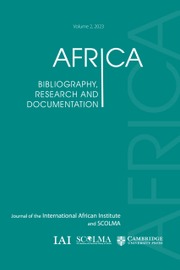No CrossRef data available.
Article contents
Chilembwe in Trafalgar Square – an appraisal
Published online by Cambridge University Press: 15 November 2023
Abstract
In September 2022 Samson Kambalu attracted international attention when his 5.5 metre statue of John Chilembwe, who led a brief, bloody and ultimately unsuccessful revolt against British colonial rule in Nyasaland in 1915, was displayed on the fourth plinth in London’s Trafalgar Square. This impressive statue towers above an accompanying statue of British missionary, the Rev. John Chorley, who was then Chilembwe’s only known white friend and confidant. The reason for their disparate heights is stated to be an indicator of their respective relevance and locus each to the other in Malawi’s rich history. The artistic merit of the statues is unquestioned. Unfortunately, an apparent lack of rigour in providing historical context to the statues may have unwittingly detracted from the already well known, powerful and compelling story of John Chilembwe. This article seeks to redress the balance in terms of historical accuracy and provide timely context to Chilembwe’s aspirations, tribulations and untimely death at the hands of African police.
Résumé
En septembre 2022, Samson Kambalu a attiré l’attention internationale lorsque sa statue de 5,50 m de John Chilembwe, qui mena en 1915 dans le Nyasaland une brève révolte sanglante infructueuse contre le régime colonial britannique, fut érigée sur le quatrième piédestal de la place Trafalgar de Londres. Cette impressionnante statue domine une statue attenante du Rev. John Chorley, le missionnaire britannique qui était le seul ami et confident blanc alors connu de Chilembwe. La différence de hauteur de ces statues est censée indiquer l’importance et la place respectives et relatives que l’un et l’autre occupent dans la riche histoire du Malawi. Le mérite artistique de ces statues est incontestable. Malheureusement, un manque apparent de rigueur dans l’exposé du contexte historique des statues peut avoir involontairement déprécié l’histoire bien connue, puissante et irréfutable de John Chilembwe. Cet article cherche à rétablir l’équilibre en termes d’exactitude historique et à fournir un contexte opportun aux aspirations, aux tribulations et au décès prématuré de Chilembwe aux mains de la police africaine.
- Type
- Article
- Information
- Copyright
- © The Author(s), 2023. Published by Cambridge University Press on behalf of the International African Institute
Footnotes
This article is an expanded adaptation of a brief, reactive article (Stuart-Mogg 2022).




